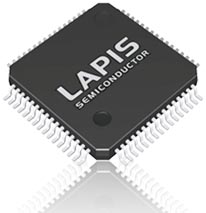Scalable design simplifies multi-cell systems increasingly demanded in the industrial equipment market
LAPIS Semiconductor, a ROHM Group company, has recently announced the development of a lithium-ion battery monitoring LSI that supports an industry-best 16 cells in series, significantly reducing the size of lithium-ion battery monitoring systems (i.e. power storage systems).

The ML5239 facilitates multi-cell monitoring and allows for multi-stage series connection to support higher voltage lithium-ion battery monitoring systems requiring more than 16 cells. In addition, current consumption during power down has been minimized to an industry-low 0.1 µA, effectively reducing system power consumption.
A comprehensive support system is offered, including evaluation board and sample software that make it easy to verify operation, along with manuals and tools that can be downloaded from our website (registration required).
High-density lithium-ion batteries, which have already been widely adopted in household power storage systems and uninterruptible power systems (UPSs), are expected to see increased demand with the proliferation of smart homes and HEMSs (Home Energy Management Systems). However, these applications require much greater battery capacities than those used for portable electronics or electric tools, necessitating battery monitoring solutions that supports multi-stage connection and higher voltages. It is also important that battery monitoring systems consume minimal current in order to ensure efficient operation in various power-sensitive applications such as emergency power supplies.
To meet these needs, LAPIS Semiconductor has developed a battery monitoring LSI optimized for high voltage lithium-ion battery monitoring systems utilizing market-proven mixed signal circuit and high-voltage processes. And going forward LAPIS Semiconductor will continue to respond to the demands of the industrial equipment market for higher voltage battery monitoring systems by offering novel multi-cell lithium-ion battery monitoring LSIs that support even greater voltages.
Key Features
- Supports up to 16 cells in series
The ML5239 is designed for lithium-ion battery monitoring systems utilizing up to 16 cells in series. And class-leading 80 V withstand voltage makes it possible to configure higher voltage systems.
- Enables multi-stage series connection
In addition to simplifying multi-cell battery monitoring, multiple LSIs can be connected in series to accommodate higher voltage systems.
- Minimizes current consumption during power-down
Current consumption is reduced to an industry-best 0.1 µA during power down, decreasing system power consumption considerably. This is particularly effective for systems with long monitoring intervals.
- Integrated A/D converter
Measured values are digitized by the built-in A/D converter and output via SPI, making it possible to construct simple, noise-resistant battery monitoring systems.
Applications
- Power storage systems, uninterruptible power supplies (UPS)
Specifications
|
Parameter
|
Specifications
|
|
No. of Cells Supported
|
16 cells (in series) (Scalable via multi-stage series connection)
|
|
Power Down Current Consumption
|
0.1 µA (typ.)
|
|
Integrated A/D Converter
|
12 bit successive approximation type ADC
|
|
Cell Voltage Measurement Accuracy
|
±10 mV (typ.)
|
|
Cell Balancing Function
|
Built-in external NMOSFET drive circuit
|
|
Temperature Sensor Measurement Function
|
Thermistor connection pin (4 ch)
|
|
Self-Diagnostic Function
|
Cell voltage measurement open/short detection pin, etc.
|
|
MCU Interface
|
SPI serial interface
(CRC communication error detection function) |
|
Operating Power Supply Voltage Range
|
+10 to +72 V
|
|
Operating Temperature Range
|
-40 to 85 °C
|
|
Package
|
TQFP64 (12 mm × 12 mm)
|
